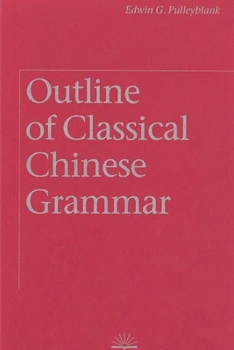Outline of Classical Chinese Grammar
Select Format
Select Condition 
Book Overview
Outline of Classical Chinese Grammar is a comprehensive introduction to the syntactical analysis of classical Chinese. Focusing on the language of the high classical period, which ranges from the time of Confucius to the unification of the empire by Qin in 221, the book pays particular attention to the Mencius, the Lúnyu, and, to a lesser extent, the Zuõzhuàn texts. Outline of Classical Chinese Grammar starts with a brief historical overview and a discussion of the relation between the writing system and the phonology. This is followed by an outline of overall principles of word order and sentence structure. The next sections deal with the main sentence types - nominal predicates, verbal predicates, and numberical expressions, which constitute a special type of quasiverbal predication. The final sections cover such topics as subordinate constitutents of sentences, nondeclarative sentence types, and complex sentences.
Format:Paperback
Language:English
ISBN:0774805412
ISBN13:9780774805414
Release Date:February 2022
Publisher:University of British Columbia Press
Length:208 Pages
Weight:1.55 lbs.
Dimensions:0.6" x 6.0" x 9.0"
Customer Reviews
4 ratings
Must have
Published by Thriftbooks.com User , 18 years ago
I don't have much to add to what other reviewers have written. But I want to give the thumbs-up for this book. It should be on the shelf of everyone who wants to read/translate/understand Classical Chinese literature.
Very useful, but sometimes hard to understand.
Published by Thriftbooks.com User , 20 years ago
First off, the more I use this book the more I like it. Despite a few "flaws" it is a book full of useful and subtle knowledge on Classical Chinese grammar and anyone serious about Classical Chinese would do well to own a copy. Despite a few short comings (discussed below) it is the most complete Classical Chinese grammar book available in English. Its emphasis is on the high classical period from Confucius (551 - 479 BCE) to the founding of the Qin dynasty (221 BCE). This book assumes the reader already knows some Classical Chinese and has a very good grasp of grammatical and linguistic terminology. Examples: 1)...this is done by inserting a resumptive pronoun shi2... 2) Both the subject and a postverbal element may be topicalized in a locative phrase with yu4 nominalized by zhi1. 3) Other modal notions are expressed by adverbial or adnominal particles. (Those new to Classical Chinese should consider: Classical Chinese : A Basic Reader in Three Volumes, ISBN: 0691118310, which compliments Michael Fuller's: An Introduction to Literary Chinese, ISBN: 0674017269, as these two books have some readings in common. In appendix A of Fuller's book there is a very nice grammar summary and it discusses some of Pulleyblank's perspectives. The grammar summary in Fuller's book is much simplier than in Pulleyblank's, but is a bit more abstract in its approach compared to what is covered in the above three volume reader. Also, Fuller's appendix D contains a very useful glossary of the most important function words. Ideally one would eventually want all these books. Note, Fuller's book doesn't give the pinyin for the actual text being analyzed, he only supplies the pinyin in his vocabulary lists, which for some reason are not always complete. Also, unlike the above three volume reader, Fuller does not provide the reader with a complete translation of the text being analyzed. Fuller's book covers texts from beginning level to advanced level and is definitely recommended. [If one is going to invest the hundreds, if not thousands of hours, required to learn Classical Chinese then one should get all the books that can help.]) Since this book is an outline organized by grammatical and linguistic concepts and written more for the scholar, it is not, in my opinion, organized in a way that is optimal for translating. Since almost everybody learns Classical Chinese by reading sections from the classics, it would be helpful, but likely contrary to the philosophy and aim of the book, if the most common grammatical patterns were summarized into one or two chapters and the full and varied usage of each individual grammatical particle were listed in one place. Sometimes when translating a difficult passage I have to look in three or four places to make sure I have covered all possible uses of one given grammatical particle. In time one remembers all the possible patterns, but it would be easier if the book was organized differently or at least had additional m
Outstanding and much-needed
Published by Thriftbooks.com User , 25 years ago
In the _Outline of Classical Chinese Grammar_, Pulleyblank provides a much-needed, well, "outline" of the grammar of the Chinese classics. My favorite aspect of this book is its extensive examples, which help the reader of classic texts bridge the gap between the orderly world of grammar books and the always-disorderly world of actual texts.Of course, one can always wish for more, e.g., I might hope for more on the usages of the various "prepositional" particles. Nevertheless, this is by far the best book of this sort I have seen (in a number of years of working with classical Chinese), and a vital aid to the student of classical Chinese.
Finally, a comprehensive grammar of Wenyan.
Published by Thriftbooks.com User , 28 years ago
I have been studying the Classical Chinese language for one year now and have been suffering through several inadequate grammar references. This wonderful book is the first comprehensive treatment of the grammar of the ancient form of Chinese used by the great philosophers like Confucius and Mencius. It uses modern grammar terminology and examples from the Classics to systematize this very complex language. Bravo.. Mr. Pulleyblank. You have strided through a field in which many have feared to tred! Anthony Barbieri-Low Harvard University Regional Studies:East Asia Program





